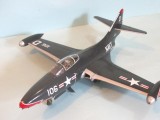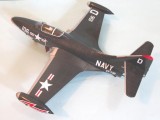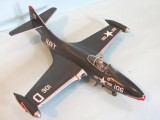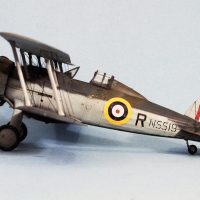Royce Williams’ Mig-killer Panther
By rights, Grumman F9F-5 Panther BuNo 125459 should be the most famous Panther of all, and her pilot, Lieutenant Royce Williams, the most famous Panther pilot of all. However, immediately after the event for which this acclaim should have been awarded, Cold War politics closed in on one of the few events where the major adversaries - armed forces of the United States and the USSR - engaged in direct combat; the events of November 18, 1952 were a closely-guarded Navy secret until details were released by the Russian government in the 1990s.
It is well known that the Grumman F9F Panther, the Navy's first line fleet fighter of the Korean era, was a first generation jet fighter outperformed by the Soviet's second generation fighter, the MiG-15. Indeed, on the two occasions where Panthers had tangled with Migs in November of 1950 and 1951, only superior pilot skill had brought the Navy fighter out on top. Such facts make the achievement of Lieutenant Williams a
year later even more extraordinary.
After two years of flying interdiction strikes in central North Korea against the communist supply lines, Task Force 77 had finally been given orders to make a direct strike against the hub of the Chinese Communist supply line. Four carriers would strike the North Korean port city of Hoeryang, at the mouth of the Yalu River on the east coast of the Korean peninsula, five miles across the water from Vladivostok, the main Soviet base on the Pacific and directly across the river from Manchuria. Because of the international sensitivity, the strikes could only be made in one direction from the southeast, with exit from the target to the southwest. November 18 was the dead of winter, with a cloud ceiling of 500 feet over the Sea of Japan in driving snow flurries from a Siberian blizzard. Nevertheless, the morning strikes were flown, and preparations were being made for a second when the fleet's air defense radars picked up incoming bogies from the direction of Vladivostok.
Aboard USS Oriskany (CV-34) four F9F-5 Panthers of VF-781 were moved to the launch position to reinforce the standing CAP in the face of the incoming threat. Normally, a fighter division is composed of pilots who have flown with each other and know each other's abilities. In this case, the four pilots assigned had never flown with each other and were chosen due to the fact that they had not had much opportunity for operational flying since VF-781 and its air group had begun their second Korean tour of duty on November 5. The Division leader was Lieutenant Claire Elwood, with wingman Lt.(j.g.) John Middleton, with Lieutenant Royce Williams as element lead with wingman Lt.(j.g.) David Rowlands.
Williams had joined VF-781 the previous summer. A graduate of the Navy's V-5 program who had won his Wings of Gold just too late for participation in World War II, Williams had remained in the post-war Navy. In 1948, he had been sent to the University of Minnesota to obtain a Bachelor's degree. While there, he had become friends with Lieutenant Commander Stan Holme, at the time the executive officer of the Naval training detachment at UM. Upon graduating in June 1950, Williams had expected to return to the fleet with the outbreak of war on June 25, but instead he was sent to two years of post-graduate study at the Armed Forces Post Graduate School in Monterey, graduating in June 1952. Assigned to a Corsair squadron at NAS Alamitos in southern California, Williams spotted the brand-new F9F-5 Panthers of VF-781, and quickly discovered that the squadron CO was Stan Holme. A quick transfer had been authorized and Williams was in the squadron when it became the first to take the new improved Panther into combat that fall.
The four Panthers were immediately on instruments as they launched into the storm and were soon swallowed in the blinding snow flurries within the clouds, their noses high, climbing under full power at 5,000 feet per minute. CIC informed them the bogies were 85 miles inbound at 50,000 feet. At 12,000 feet, they broke out of the storm clouds into clear skies, and continued climbing. At 24,000 feet they spotted seven contrails high above, with silver arrows at their head. Williams, one of the best shots in the Navy, quickly cleared his four 20mm cannons with a burst of fire. “I flipped on my gunsight and fired a burst to test my guns. At that moment, Lieutenant Elwood, the Flight Leader, reported his fuel pump warning light had come on. The CIC directed him to report overhead the Oriskany. He passed the lead to me and turned back to the task force with his wingman flying as his safety escort.” The odds went from four against seven to two against seven as the MiGs continued inbound and the two Panthers continued climbing.
“We were just going through 26,000 feet when the Russians split up and dove out of the contrail layer; the first ones came at us from the side in a four-plane formation, shooting. I pulled into a hard climbing left turn and came around on the Number Four MiG. I fired a burst and he went down smoking. My wingman then followed him down, leaving me alone.” The three remaining MiGs of that group positioned themselves for another firing run, reversing course as Williams turned into them again and again, firing as they flashed by at a very high closure rate. “They had me cold on maneuverability and acceleration - the MiG was vastly superior on those counts to the F9F.” The other three MiGs joined in and Williams was now dog-fighting five MiGs in an airplane that shouldn't have been able to compete. In the midst of maneuvering, he spotted a MiG locked on his six o'clock position; executing a very hard turn he escaped. Several times he tracked an individual MiG and fired rounds that appear to hit, but he couldn't follow up, instead trying to keep his six o'clock clear. “I was firing at every MiG that passed within gun range as they came by.” He kept the Panther at full throttle, each time turning into the enemy fighters as they commenced a firing pass.
“Finally, the leader and his wingman went off to the right while I went after the section leader of the plane I'd shot down. He went into the sun and I lost him, then I saw the leader and wingman come around for a diving attack on me. I turned into them and fired at the leader. He turned away and the wingman rolled down on me and we went past belly-to-belly as I raked him with a long burst. He went down on fire.” Williams pulled up and away from the burning enemy fighter. “The section leader then came around and I turned into him and fired at him and he went down. The Leader then came around again and I fired and parts came off him as he dove away.” In the fight of his life, Royce Williams had done what no other American pilot accomplished in the Korean War: shoot down four MiG-15s in one mission.
It wasn't over. “As I maneuvered to avoid the wreckage, I was porpoising to try and clear my tail. I was tracking another wounded MIG when I suddenly spotted one of the others as he slid in on my six. He fired a burst with his 37mm cannon and hit me in the wing. The shell went into the engine and messed up the hydraulic unit in the accessory section and I suddenly lost rudder and flaps and only had partial aileron control; the only thing that really worked were the elevators. I dove toward the cloud deck below at 13,000 feet, and he was 500 feet behind me and still shooting. My wingman finally got back in the fight and came in on him and he pulled away as I went into the clouds.” Williams was in serious trouble as he fought for control of the Panther, hoping he could pull out of his dive. “I came out of the clouds at around 400 feet. I was too low to eject; you had to be above 1,200 feet and climbing to successfully eject from a Panther, so I was stuck with staying in the airplane, like it or not. I soon discovered it was uncontrollable below 170 knots, so I had to maintain high speed regardless.” Several of the destroyers escorting the task force opened fire on Williams as he passed a few hundred feet overhead. “Fortunately, I was low enough and fast enough they didn't have a chance to really aim, so nobody hit me.”
Landing speed for a Panther is 105 knots, but there was no way Williams could do that. Oriskany cleared her deck, turned into the wind and cranked up to full speed, bucking through the huge waves at 30 knots as the flight deck rose and fell through a 20 foot arc. It was obviously going to be a crash landing. “I didn't want to ditch, because I wasn't sure I could make a successful ditching, and that water was cold enough I knew I wouldn't last ten minutes even in my poopy suit. The Oriskany's captain headed the ship just away from the wind, which gave me the opportunity to come aboard, and I caught the three wire and shut her down.”
Williams climbed out to examine his riddled airplane. The Panther had taken 263 hits, mostly 23mm, and Williams had fired off all 760 rounds of his 20mm cannons. “That 37mm hit in the engine accessory compartment had been really lucky. Had it been one foot aft it would have blown up the engine; had it been one foot forward, it would have severed the spar and blown off my wing.” After removing everything of value from BuNo 125459, the deck crew heaved the broken carcass overboard and it disappeared into the dark sea.
Williams' battle was truly a performance for the record books. However, so far as the Navy was concerned, this opened the proverbial “can of worms” and would be unheard-of for fifty years. A preliminary version of the mission was compiled that became the official story, though it had little connection with the actual facts: Williams was credited with a kill. Lt.(j.g.) John Middleton, wingman to Division leader Elwood was vectored toward a descending MIG at the end of the 35 minute flight; as he approached and fired a burst out of range, the pilot ejected, and he was credited with a single kill. Williams' wingman, Dave Rowlands - who never fired a shot in the entire combat - was awarded a probable.
Once the Oriskany returned to Yokosuka the following week, Williams was ordered to report to Vice Admiral Robert P. Briscoe, Commander Naval Forces Far East, who informed him that the then-new National Security Agency had a team aboard the cruiser USS Helena which recorded all the Russian radio traffic leading up to and during the fight; they had warned the fleet when the Russians decided to send aircraft into the combat area. There was no way the fight could be publicized, since there was too much chance the Russians would learn how they had been spotted. At the highest levels of US and UN command, there was real fear that such an “incident” between US forces and Soviet forces could change the “police action” of Korea into World War III. Never mind that Air Force pilots were fighting hundreds of Russian “volunteers” flying MiG-15s with North Korean markings in “MiG Alley,” this was a fight that had directly pitted the two great Cold War adversaries against each other nose-to-nose. The Admiral told Williams the NSA team had proof he had gotten at least three of the MiGs, and that the fourth had crash landed. Unfortunately, his gun camera footage had been “edited” by a sailor aboard the Oriskany and only showed portions of the encounter, with two MiGs being hit solidly.
Williams would remain quiet about the event for 50 years while he flew with Air Force Korean aces at the Fighter Weapons School at Nellis, and commanded other Navy fighter squadrons through the Cold War and three carrier air groups in Vietnam. In 1992, following the end of the Cold War, the Russians revealed Williams had indeed gotten four: Captain Belyakov, Captain Vandalov, Lieutenant Pakhomkin and Lieutenant Tarshinov of the Red Navy Air Force. Vandalov, Pakhomkin and Tarshinov had all been directly shot down in the fight. Belyakov, the flight leader, had been badly shot up by Williams and crash-landed as soon as he was over Soviet territory, being killed in the crash. Royce Williams was the top-scoring carrier-based Naval Aviator of the “forgotten war” and the top-scoring Naval Aviator in a Navy jet (Guy Bordelon scored 5 in an F4U-5N Corsair and Marine Major John Bolt scored six flying an F-86 with the Air Force). His score of four MiGs in one fight is a performance unequaled since.
UPDATE: Amazingly enough, despite these events having taken place 68 years ago now (2020), the U.S. Navy History & Heritage Command removed the USS Oriskany Monthly Report for November 1952 - which contained the full "cover story" and all other details - from its collection of USN carrier reports for the Korean War, following publication of my book in 2019, in which this story is Chapter One, following my query to them as to whether they would like to revise their official history - their response was that such could only be done on the sworn testimony of two US witnesses. Following that, the report was replaced by the November 1952 Air Group Report, which is far less detailed. When contacted, NHHC responded that "... unfortunately not all reports were saved to be placed in our archives." I responded by attaching the PDF of the original Monthly Report that I had downloaded in 2018 while researching the book. As of October 21, 2020, NHHC has failed to reply. And despite the fact they now definitely possess the report, it still cannot be found on their site.
(Shameless personal plug: for more of this story, see the June 2013 issue of Flight Journal, or my book "Holding The Line: U.S. Naval Aviation in the Korean War," published by Osprey in 2019.)
The kit is the Monogram F9F-5, using the Eagle Strike 48114 Panther sheet, modified to do 106D BuNo 125459 (the sheet gives 109-D) of VF-781. If you visit the USS Midway museum in San Diego, they have an F9F-5 done up as my friend Royce's airplane, only painted "Blue Angel Blue."

















That's a very nice build Tom, and I really enjoyed the backstory. I had never heard of it and I can see why now. Thanks for that!
Gary
Superb work, Tom! An outstanding build of an unknown but historically significant aircraft. I had read accounts of this mission, and I bought this same Aeromaster sheet years ago, but never made the connection between the two. I'll definitely be using these markings when I get around to building the Monogram Panther in my stash.
Great story.
Great story and the frame work for a great movie. I always think truth is stranger than fiction and Mr Williams is deserving of the recognition of his bravery and service to his country. Of course the Korean War was really a police action... too bad William Holden passed away he'd be the perfect actor too.
Tom. I in AWE of the article here .. I wish my Dad and you could share some
"sea stories" of your flight time "in the air" ...THANK YOU for your service !
how long did it take you to get used to "FLIGHT QUARTERS" !?
Royce is a good friend/squadron mate of mine from different eras...he's just awesome...hero...and we've shared many great stories...God Bless him...
A little late, but why didn't History channel cover Mr. Williams in the Dogfight series?
Because they didn't know (trust me, those folks who made the show were not the sharpest blades in the box
I tend to agree. I watch their shows with a grain of salt.
Tom, great account of the incident! Your bird is excellent but the background story makes it come alive. I really enjoy some history along with the photos.
Great job on the Panther. I'm in the process of building the same kit with the intention of also doing the Royce Williams aircraft. The problem is the Eagle Strike 48-114 sheet is out of production. Do you happen to have an extra one you might part with? I know it's a long shot, but what the heck! I really only need the lightning bolts for the tip tanks since they are a different style than that used on the -2, which is what I'm trying to use. I have enough Panther sheets to make the decal changes needed with the exception of the tip tank decal. Thanks, Gary
Sorry, nope. And I did an internet check and none of the "usual suspects" have it either.
Yea, I've done the search. Thanks for getting back to me. Gary